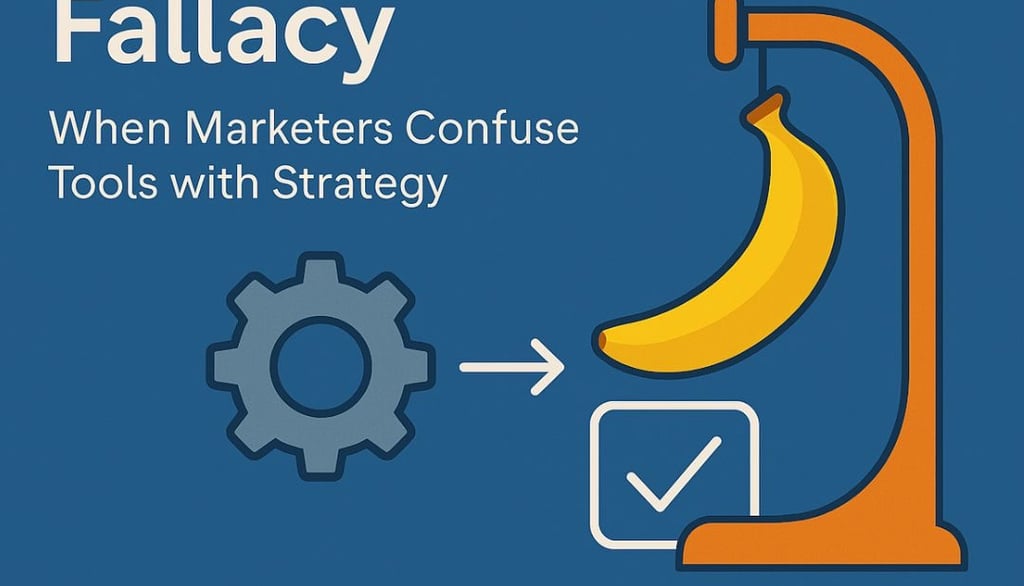The Banana Holder Fallacy: When Marketers Confuse Tools with Strategy
A sharp look at how marketers mistake tools for strategy, featuring banana holders, automation gone wild, and a reminder to refocus on what actually drives growth: clarity, customers, and common sense.
MARKETING AND CONTENT
Brandon Lee Alsup
3/25/20252 min read


MARKETERS LOVE tools. (Guilty.)
Lately, especially AI tools.
So much so that entire campaigns get built backwards from them.
The Banana Holder Fallacy: When Marketers Confuse Tools with Strategy
Marketer: “We’ll scrape emails with Tool A, cross-reference LinkedIn and college mascots with Tool B, and then automate the creation of 3,000 customized banana holders in school colors using Tool C! And we’ll get them all shipped without lifting a finger!! It’s almost too easy.”
Client: “Why banana holders?”
Marketer: “Don’t slow me down! Banana holders are just the start!”
Four months and 2,000 banana holders later?
No meetings
No pipeline
Plenty of “backsplaining” what happened
This is what I call the Banana Holder Fallacy: the belief that enough clever automation at massive scale = results.
I know, because I’ve been there—and from time to time, I still find myself slipping into believing that tools are the answer.
Let me be clear: activity ≠ impact.
Sure, activity can lead to impact—but it’s not guaranteed.
As a marketer, my job is growth.
Specifically: top-line revenue. That’s it.
If revenue isn’t growing, more likely than not, I’m missing the mark.
So I have to take an honest look at my daily work and put each task into one of two buckets:
Marketing busywork
Needle-moving work
Dashboards and metrics can absolutely help—measuring is how you know if you're on the right track. But too often, I’ve caught myself filling them out just so I have something to show the team. It feels like momentum, but it isn’t.
Somewhere in the wreckage of shiny tools and marketing theater, it’s easy to forget:
Who the customer is
What the customer actually wants
What would make someone care enough to reply
And—most importantly—what kind of business you’re marketing for
Marketing advice can feel like professional Instagram comparison syndrome:
Did you see what they did? She just launched a podcast, ran a viral campaign, closed 80 deals, and her team does TikTok dances while coding in three languages. And she just had twins!
It’s easy to fall into comparison mode:
“Why aren’t we on Instagram?”
“Shouldn’t we have a podcast?”
“Someone said SEO is dead—why are we still playing the search game?”
Pull back from the brink.
Zoom in on your market. Your demographic. Your business goals.
For example, I work with Kosh Solutions, a “smedium” Managed IT Service Provider. Success for us means 15% growth, which we achieve by signing 5 to 10 new contracts per year.
To get there, we don’t need a podcast.
We don’t need Instagram.
We don’t need TikTok.
We need to:
Provide an insanely great service experience
Work our referral network
Show up on Google when someone searches
That’s it.
Here are the questions I return to when the noise gets loud:
Is your strategy driven by human insight—or by the promise of what a tool might do?
Or worse, by what someone in a totally different industry says worked for them?
Because in my experience, effective marketing doesn’t start with tech.
It starts with clarity and customer understanding.
Over time, I’ve developed the ability to say:
“This is who we serve. Here’s why they care. And here’s how we’ll reach them.”
Tools can and should help. But they can’t lead.
If you’re like me and have built the most beautiful funnel but aren’t getting results—stop.
Unplug the banana holders.
Admit when something you thought was clever just didn’t work. Let it go. (Sorry, cybersecurity checklist.)
When I get off track, I talk to a customer.
That simple act tends to realign everything.
Then I build from there.
MAKE CONTACT
Address
Las Cruces, NM 88007
575-642-8363
brandon@ashrivers.com




